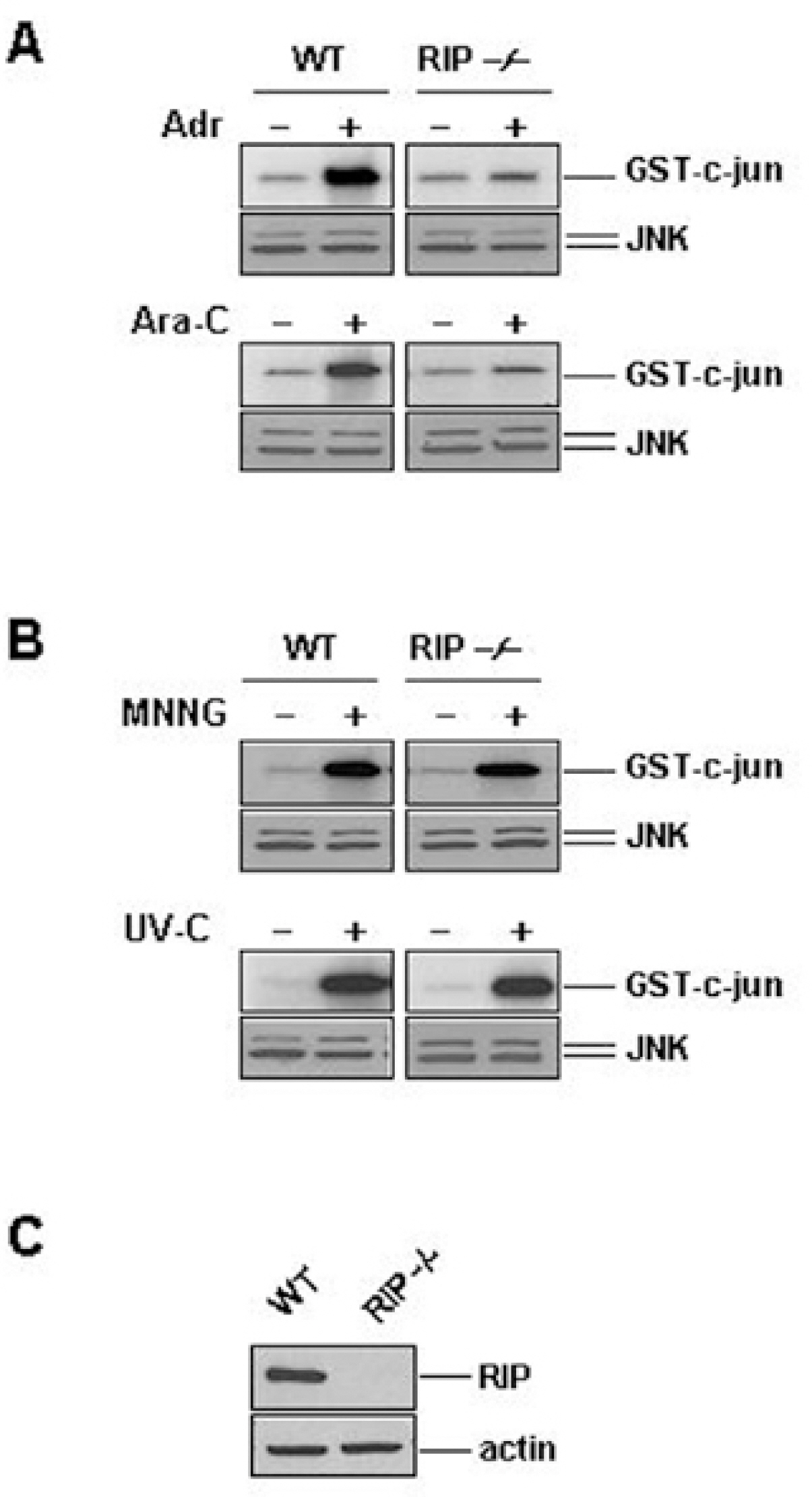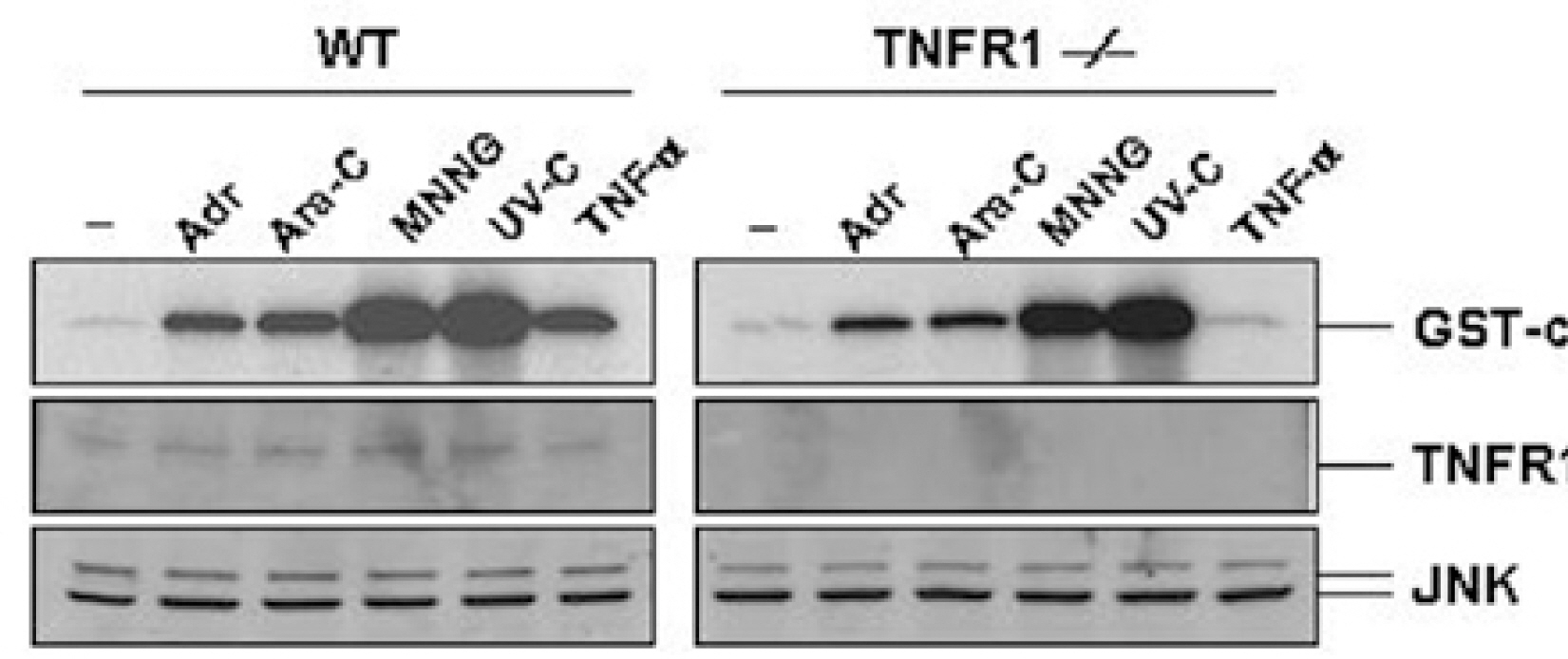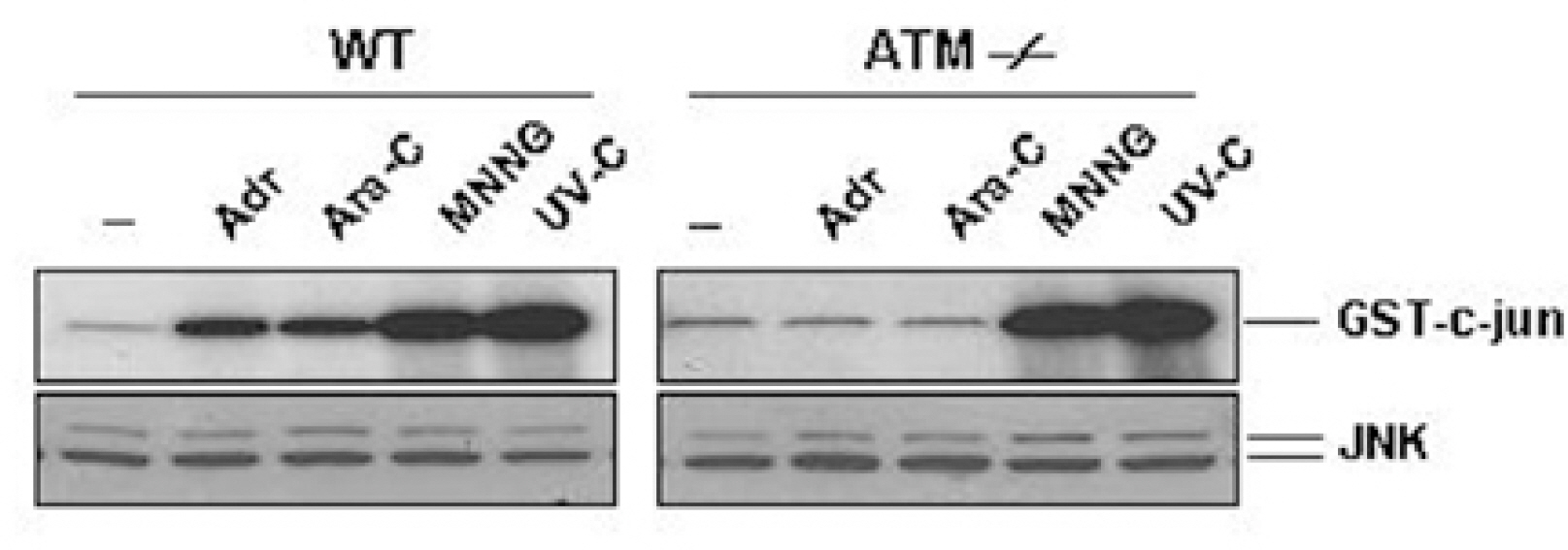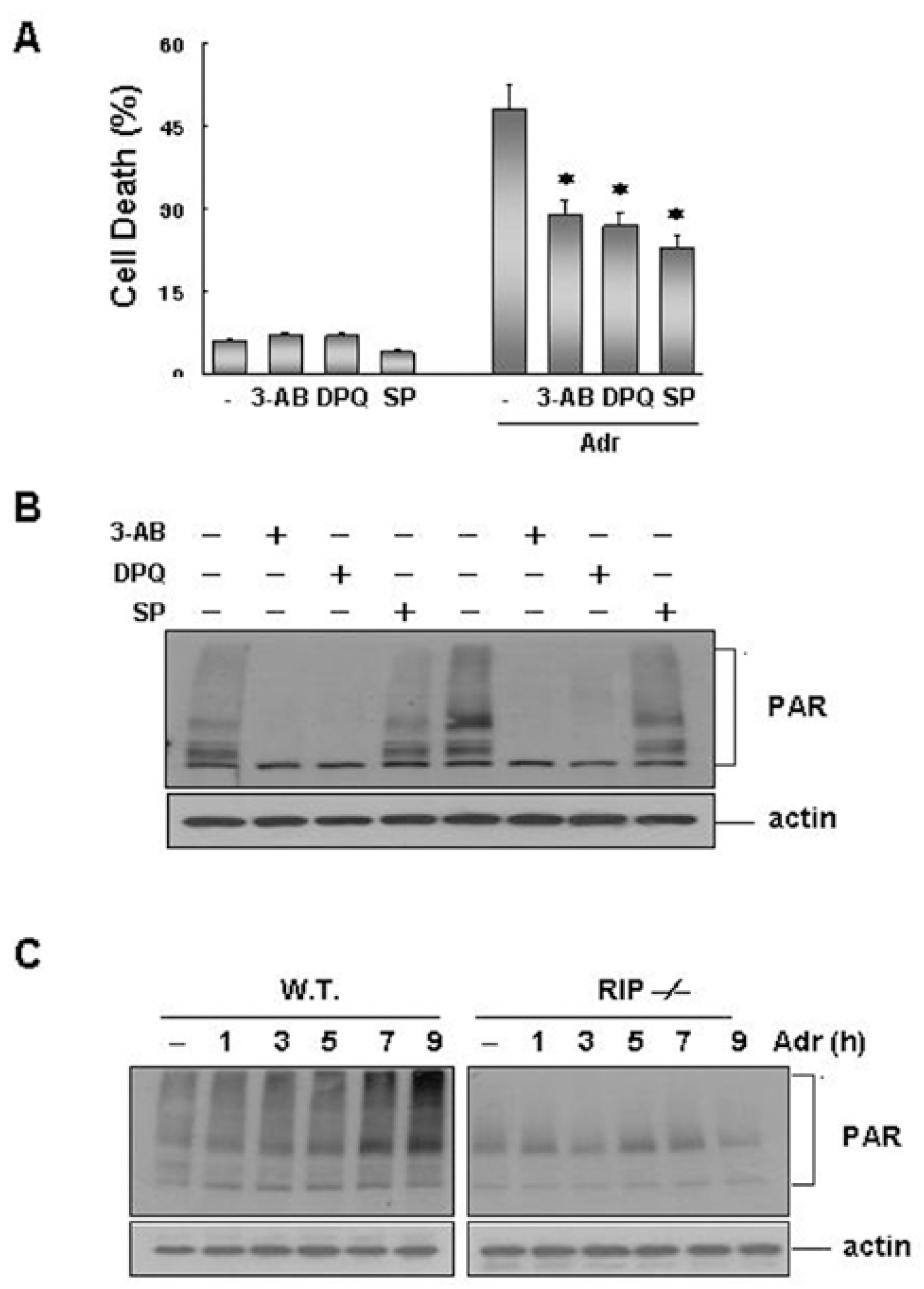Korean J Physiol Pharmacol.
2008 Aug;12(4):185-191. 10.4196/kjpp.2008.12.4.185.
Long-term Activation of c-Jun N-terminal Kinase through Receptor Interacting Protein is Associated with DNA Damage-induced Cell Death
- Affiliations
-
- 1Department of Pharmacology, Research Institute for Medical Sciences, College of Medicine, Chungnam National University, Daejeon, Korea. gmhur@cnu.ac.kr
- 2Daejeon Regional Cancer Center, College of Medicine, Chungnam National University, Daejeon, Korea.
- KMID: 1838357
- DOI: http://doi.org/10.4196/kjpp.2008.12.4.185
Abstract
- Activation of c-Jun N-terminal kinase (JNK), a member of the mitogen-activated protein kinase family, is an important cellular response that modulates the outcome of the cells which are exposed to the tumor necrosis factor (TNF) or the genotoxic stress including DNA damaging agents. Although it is known that JNK is activated in response to genotoxic stress, neither the pathways to transduce signals to activate JNK nor the primary sensors of the cells that trigger the stress response have been identified. Here, we report that the receptor interacting protein (RIP), a key adaptor protein of TNF signaling, was required to activate JNK in the cells treated with certain DNA damaging agents such as adriamycin (Adr) and 1-beta-D-arabinofuranosylcytosine (Ara-C) that cause slow and sustained activation, but it was not required when treated with N-methyl-N-nitro-N-nitrosoguanidine (MNNG) and short wavelength UV, which causes quick and transient activation. Our findings revealed that this sustained JNK activation was not mediated by the TNF (tumor necrosis factor) receptor signaling, but it required a functional ATM (ataxia telangiectasia) activity. In addition, JNK inhibitor SP-600125 significantly blocked the Adr-induced cell death, but it did not affect the cell death induced by MNNG. These findings suggest that the sustained activation of JNK mediated by RIP plays an important role in the DNA damage-induced cell death, and that the duration of JNK activation relays a different stress response to determine the cell fate.
Keyword
MeSH Terms
Figure
Reference
-
Angel P., Karin M. The role of Jun, Fos and the AP-1 complex in cell-proliferation and transformation. Biochim Biophys Acta. 1072:129–157. 1991.
ArticleBakkenist CJ., Kastan MB. DNA damage activates ATM through intermolecular autophosphorylation and dimer dissociation. Nature. 421:499–506. 2003.
ArticleBulavin DV., Saito S., Hollander MC., Sakaguchi K., Anderson CW., Appella E., Fornace AJ Jr. Phosphorylation of human p53 by p38 kinase coordinates N-terminal phosphorylation and apoptosis in response to UV radiation. EMBO J. 18:6845–6854. 1999.
ArticleByun HS., Park KA., Won M., Yang KJ., Shin S., Piao L., Kwak JY., Lee ZW., Park J., Seok JH., Liu ZG., Hur GM. Phorbol 12-myristate 13-acetate protects against tumor necrosis factor (TNF)-induced necrotic cell death by modulating the recruitment of TNF receptor 1-associated death domain and receptor-interacting protein into the TNF receptor 1 signaling complex: Implication for the regulatory role of protein kinase C. Mol Pharmacol. 70:1099–1108. 2006.
ArticleCanman CE., Kastan MB. Signal transduction. Three paths to stress relief. Nature. 384:213–214. 1996.Chen YR., Wang X., Templeton D., Davis RJ., Tan TH. The role of c-Jun N-terminal kinase (JNK) in apoptosis induced by ultraviolet C and gamma radiation. Duration of JNK activation may determine cell death and proliferation. J Biol Chem. 271:31929–31936. 1996.Chen G., Goeddel DV. TNF-R1 signaling: a beautiful pathway. Science. 296:1634–1635. 2002.
ArticleCoso OA., Chiariello M., Yu JC., Teramoto H., Crespo P., Xu N., Miki T., Gutkind JS. The small GTP-binding proteins Rac1 and Cdc42 regulate the activity of the JNK/SAPK signaling pathway. Cell. 81:1137–1146. 1995.Derijard B., Hibi M., Wu IH., Barrett T., Su B., Deng T., Karin M., Davis RJ. JNK1: a protein kinase stimulated by UV light and Ha-Ras that binds and phosphorylates the c-Jun activation domain. Cell. 76:1025–1037. 1994.
ArticleDevary Y., Rosette C., DiDonato JA., Karin M. NF-kappa B activation by ultraviolet light not dependent on a nuclear signal. Science. 261:1442–1445. 1993.
ArticleFritz G., Kaina B. Activation of c-Jun N-terminal kinase 1 by UV irradiation is inhibited by wortmannin without affecting c-iun expression. Mol Cell Biol. 19:1768–1774. 1999.Hayakawa J., Depatie C., Ohmichi M., Mercola D. The activation of c-Jun NH2-terminal kinase (JNK) by DNA-damaging agents serves to promote drug resistance via activating transcription factor 2 (ATF2)-dependent enhanced DNA repair. J Biol Chem. 278:20582–20592. 2003.
ArticleHeeres JT., Hergenrother PJ. Poly (ADP-ribose) makes a date with death. Curr Opin Chem Biol. 11:644–653. 2007.Houghton JA. Apoptosis and drug response. Curr Opin Oncol. 11:475–481. 1999.
ArticleHur GM., Lewis J., Yang Q., Lin Y., Nakano H., Nedospasov S., Liu ZG. The death domain kinase RIP has an essential role in DNA damage-induced NF-kappa B activation. Genes Dev. 17:873–882. 2003.Hur GM., Kim YS., Won M., Choksi S., Liu ZG. The death domain kinase RIP has an important role in DNA damage-induced, p53-independent cell death. J Biol Chem. 281:25011–25017. 2006.
ArticleIchijo H., Nishida E., Irie K., ten Dijke P., Saitoh M., Moriguchi T., Takagi M., Matsumoto K., Miyazono K., Gotoh Y. Induction of apoptosis by ASK1, a mammalian MAPKKK that activates SAPK/JNK and p38 signaling pathways. Science. 275:90–94. 1997.
ArticleKarin M., Lin A. NF-kappaB at the crossroads of life and death. Nat Immunol. 3:221–227. 2002.Kharbanda S., Ren R., Pandey P., Shafman TD., Feller SM., Weichselbaum RR., Kufe DW. Activation of the c-Abl tyrosine kinase in the stress response to DNA-damaging agents. Nature. 376:785–788. 1995.Kyriakis JM., Banerjee P., Nikolakaki E., Dai T., Rubie EA., Ahmad MF., Avruch J., Woodgett JR. The stress-activated protein kinase subfamily of c-Jun kinases. Nature. 369:156–160. 1994.
ArticleLewis C., Low JA. Clinical poly (ADP-ribose) polymerase inhibitors for the treatment of cancer. Curr Opin Investig Drugs. 8:1051–1056. 2007.Lin Y., Devin A., Cook A., Keane MM., Kelliher M., Lipkowitz S., Liu ZG. The death domain kinase RIP is essential for TRAIL (Apo2L)-induced activation of IkappaB kinase and c-Jun N-terminal kinase. Mol Cell Biol. 20:6638–6645. 2000.Liu ZG., Baskaran R., Lea-Chou ET., Wood LD., Chen Y., Karin M., Wang JY. Three distinct signalling responses by murine fibroblasts to genotoxic stress. Nature. 384:273–276. 1996.
ArticleOsborn MT., Chambers TC. Role of the stress-activated/c-Jun NH2-terminal protein kinase pathway in the cellular response to adriamycin and other chemotherapeutic drugs. J Biol Chem. 271:30950–30955. 1996.
ArticlePandey P., Raingeaud J., Kaneki M., Weichselbaum R., Davis RJ., Kufe D., Kharbanda S. Activation of p38 mitogen-activated protein kinase by c-Abl-dependent and independent mechanisms. J Biol Chem. 271:23775–23779. 1996.
ArticleParra M., Lluis F., Miralles F., Caelles C., Munoz-Canoves P. The cJun N-terminal kinase (JNK) signaling pathway mediates induction of urokinase-type plasminogen activator (uPA) by the alkylating agent MNNG. Blood. 96:1415–1424. 2000.
ArticleRaingeaud J., Whitmarsh AJ., Barrett T., Derijard B., Davis RJ. MKK3- and MKK6-regulated gene expression is mediated by the p38 mitogen-activated protein kinase signal transduction pathway. Mol Cell Biol. 16:1247–1255. 1996.
ArticleRosette C., Karin M. Ultraviolet light and osmotic stress: activation of the JNK cascade through multiple growth factor and cytokine receptors. Science 274: 1194−1197. 1996.
ArticleSheikh MS., Antinore MJ., Huang Y., Fornace AJ. Ultravioletirradiation-induced apoptosis is mediated via ligand independent activation of tumor necrosis factor receptor 1. Oncogene. 17:2555–2563. 1998.Shu HB., Takeuchi M., Goeddel DV. The tumor necrosis factor receptor 2 signal transducers TRAF2 and c-IAP1 are components of the tumor necrosis factor receptor 1 signaling complex. Proc Natl Acad Sci. 93:13973–13978. 1996.
ArticleTang F., Tang G., Xiang J., Dai Q., Rosner MR., Lin A. The absence of NF-kappaB-mediated inhibition of c-Jun N-terminal kinase activation contributes to tumor necrosis factor alpha-induced apoptosis. Mol Cell Biol. 22:8571–8579. 2002.Tobin D., van Hogerlinden M., Toftgard R. UVB-induced association of tumor necrosis factor (TNF) receptor 1/TNF receptor-associated factor-2 mediates activation of Rel proteins. Proc Natl Acad Sci. 95:565–569. 1998.
ArticleTournier C., Dong C., Turner TK., Jones SN., Flavell RA., Davis RJ. MKK7 is an essential component of the JNK signal transduction pathway activated by proinflammatory cytokines. Genes Dev. 15:141914–141926. 2001.
ArticleWang JY. Regulation of cell death by the Abl tyrosine kinase. Oncogene. 19:5643–5650. 2000.
ArticleYoshida K., Miki Y., Kufe D. Activation of SAPK/JNK signaling by protein kinase Cdelta in response to DNA damage. J Biol Chem. 277:48372–48378. 2002.Zhang Y., Ma WY., Kaji A., Bode AM., Dong Z. Requirement of ATM in UVA-induced signaling and apoptosis. J Biol Chem. 277:3124–3131. 2002.
ArticleZhang S., Lin Y., Kim YS., Hande MP., Liu ZG., Shen HM. c-Jun N-terminal kinase mediates hydrogen peroxide-induced cell death via sustained poly (ADP-ribose) polymerase-1 activation. Cell Death Differ. 14:1001–1010. 2007.
- Full Text Links
- Actions
-
Cited
- CITED
-
- Close
- Share
- Similar articles
-
- The Activation of Caspase - 3 and Mitogen - activated Protein Kinases during H . Pylori - induced Apoptosis in Gastric Cancer Cells
- Cytosolic accumulation of gammaH2AX is associated with tropomyosin-related kinase A-induced cell death in U2OS cells
- UVC induced translocation of protein kinase C (PKC) and expression change of c-myc oncogene in human skin keratinocytes
- Ghrelin Inhibits Oligodendrocyte Cell Death by Attenuating Microglial Activation
- Activation of epidermal growth factor receptor is responsible for pervanadate-induced phospholipase D activation







